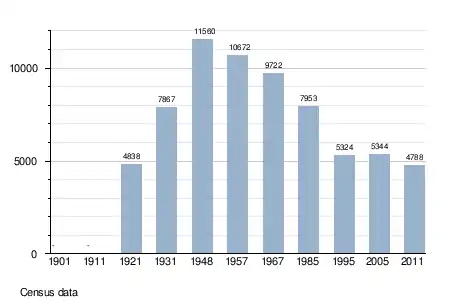Marsa, Malta
Marsa (Maltese: Il-Marsa) is a town in the South Eastern Region of Malta, with a population of 4,401 people as of March 2014.[1] The name Marsa means "the harbour".[2]
Marsa
Il-Marsa | |
|---|---|
 View of Marsa parish church | |
 Flag  Coat of arms | |
 | |
| Coordinates: 35°53′0″N 14°29′41″E | |
| Country | |
| Region | South Eastern Region |
| District | Southern Harbour District |
| Borders | Floriana, Ħamrun, Luqa, Paola, Qormi |
| Government | |
| • Mayor | Josef Azzopardi (PL) |
| Area | |
| • Total | 2.8 km2 (1.1 sq mi) |
| Population (Jan. 2019) | |
| • Total | 5,454 |
| • Density | 1,900/km2 (5,000/sq mi) |
| Demonym(s) | Marsi (m), Marsija (f), Marsin (pl) |
| Time zone | UTC+1 (CET) |
| • Summer (DST) | UTC+2 (CEST) |
| Postal code | MRS |
| Dialing code | 356 |
| ISO 3166 code | MT-26 |
| Patron saint | Maria Regina Holy Trinity |
| Day of festa | Last Sunday of August First Sunday of June |
| Website | Official website |
History
Marsa is located on the Marsa Creek, a body of water formed by the flow of water from wadis in high ground near the sea. The creek includes the Grand Harbour which the town is based on. A port was first established at Marsa by the Phoenicians. Remains of Roman constructions have been found close to the town.[2]
At the arrival of the Order of St John in Malta, a particular cultivated garden was among the few places observed.[3] A vital spring for the Grand Harbour was located on site.[4] It is thought a foundry of the Order may have been located at Marsa.[2] During the Great Siege of Malta of 1565, Marsa was used as a camp by troops of the Ottoman Empire. Following their defeat, Marsa became a barony containing a number of vineyards.[2] A noteworthy bridge was located in Marsa which facilitated the road from Birgu to the area of Valletta and vice versa.[4]
.jpg.webp)
In the 17th century a historical museum, the Museo di San Giacomo, was located at Marsa. This was created when Giovanni Francesco Abela converted his house into a museum and was the first of its type on Malta. Many of its artefacts are now held at the National Museum of Archaeology in Malta's capital city Valletta.[2]
During the French blockade of 1798-1800, Maltese insurgents built Marsa Battery and Jesuit Hill Battery in Marsa to encircle the French in the Grand Harbour. Both batteries were demolished after the end of the blockade.[5]
A new port was constructed in the 1860s under the rule of the British Empire. It was intended that a town would be built at the site under the name Albert Town, named after Prince Albert. By 1890 the town had a population of over 600 people, but it was later abandoned. A new town at the site emerged in the 20th century, taking the name Marsa after the creek.[2]
In July 2009 a plan to regenerate the harbour area was announced. This is intended to turn the site into a recreational area and is planned include the construction of a marina with space for 170 boats.[6]
Facilities

Marsa is home to the Malta Shipyards. In November 2014, the Malta Shipbuilding in Marsa was also the venue for both the 12th annual Junior Eurovision Song Contest and the Malta Eurovision Song Contest 2015.[2]
Since 1953, the oil-fueled Marsa Power Station provided most of the electricity to the Maltese Islands,[7] until it began to be demolished in 2014. A new Marsa north distribution centre will be built instead of the former power station, in order to reinforce the island's power grid.[8]
Marsa Race Track, a one-kilometre long horse racing track, was constructed in 1868 and remains in use.[9]
Malta's postal administration MaltaPost has its head office in Qormi Road, Marsa. The General Post Office, Central Mail Room and Philatelic Bureau have been located in this complex since 1997.[10]
Zones in Marsa
- Albert Town[11]
Demographics


References
- "Estimated Population by Locality 31st March, 2014". Government of Malta. 16 May 2014. Archived from the original on 21 June 2015.
- Town At A Crossroad. Marsa Local Council. Retrieved 11 July 2014.
- Leopardi, E. R. (1949). "The First Printed Description of Malta : Lyons 1536" (PDF). Scientia. 15 (2): 56, 58.
- Ganado, Ganado (2007). "The Map of Johannes Quintinus Haeduus and its Dervatives" (PDF). Symposia Melitensia. University of Malta. 4 (3): 115, 118.
- Spiteri, Stephen C. (May 2008). "Maltese 'siege' batteries of the blockade 1798-1800" (PDF). Arx - Online Journal of Military Architecture and Fortification (6): 36–37. Retrieved 25 June 2015.
- "Marsa menqa regeneration plan unveiled". The Times of Malta. 3 July 2009. Retrieved 26 February 2011.
- Joseph A. Agius (1986). Planned development of the Maltese electricity supply system (PDF) (Thesis).
- Martin, Ivan (28 October 2014). "Marsa power station: The beginning of the end". Times of Malta. Retrieved 7 December 2014.
- Richards, Brian (2008). Malta. New Holland Publishers. p. 27. ISBN 978-1845373610.
- "Maltapost privatisation latest red-letter day in postal history". Times of Malta. 21 January 2008. Retrieved 11 July 2014.
- Cassar Pullicino, Joseph (October–December 1949). "The Order of St. John in Maltese folk-memory" (PDF). Scientia. 15 (4): 163. Archived from the original (PDF) on 17 April 2016.
- "Bridgwater Twinning Association". Bridgwater Town Council. Retrieved 18 July 2013.
External links
| Wikimedia Commons has media related to Marsa (Malta). |